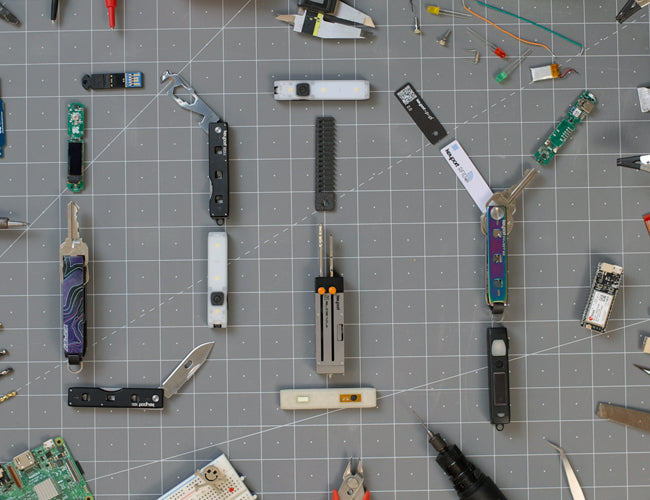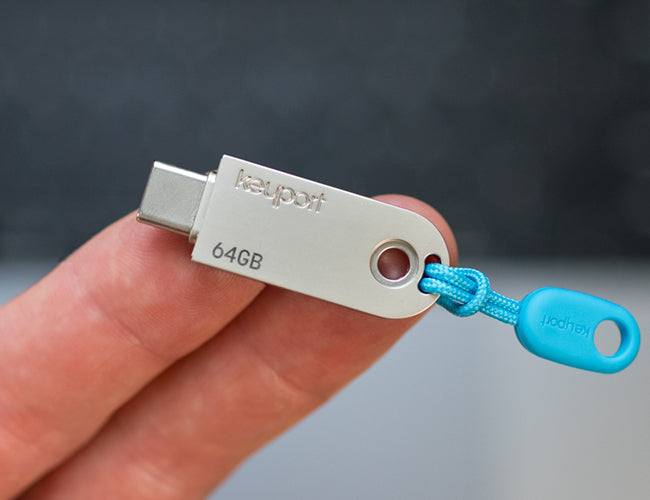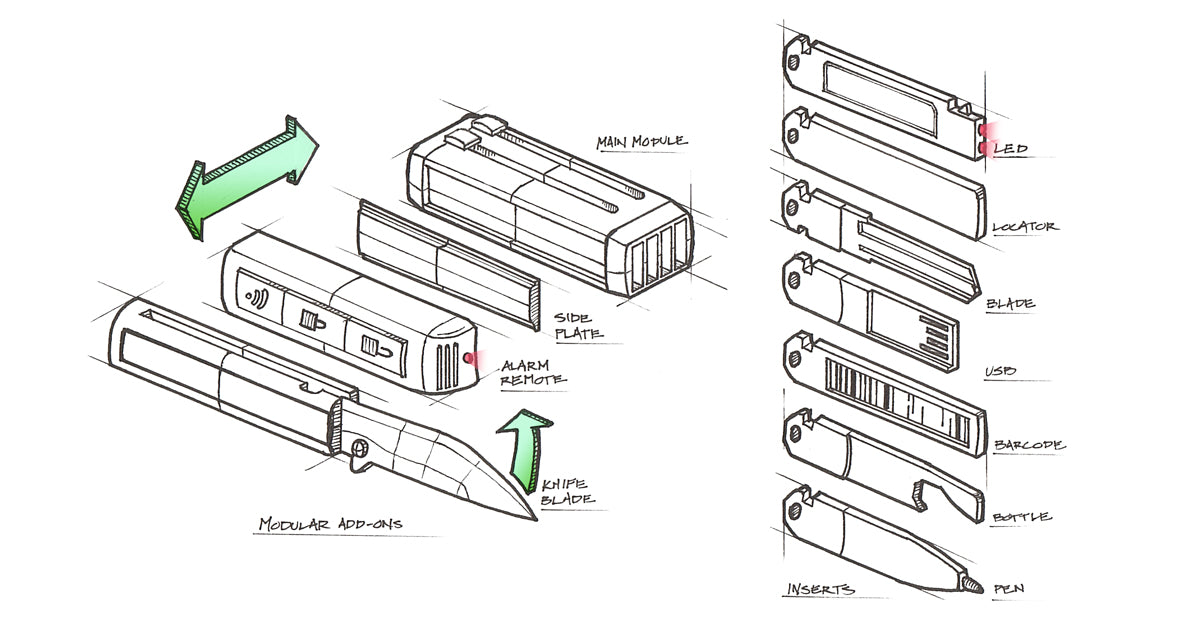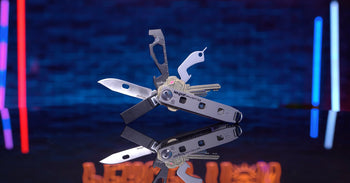

The Keychain Is Dead
Romans carried keys. So do you. That’s the problem.
For over 2,000 years, people have been tethered to jangly pieces of metal. In 1922, the split-ring keychain was invented, and it hasn’t evolved since.
Meanwhile, your phone replaced your camera, your wallet slimmed down, your car became a computer. Yet your keys? Still dangling on a $0.05 coil of wire.
Key organizers promise something better: compact, quiet, and customizable tools that fit modern life, like a modern-day renaissance man in your pocket.
The shift from traditional keychains to key organizers didn’t happen by accident. In 2007, Keyport introduced the first modern key organizer, rethinking how keys could be carried with precision, comfort, and security. Over the years, the Keyport Pivot and Keyport Slide have both been featured in best key organizer lists for their innovation and build quality, proof that even as designs evolve, practicality and craftsmanship never go out of style.
Keychain Checkmate: Why Key Organizers Win
The traditional keychain is obsolete. It’s bulky, noisy, insecure, and out of sync with modern life. The smarter alternative is a modular key organizer like Keyport: compact, fully customizable, and built for 2025 and beyond.
Helping Write the Keychain’s Obituary
Keyport isn’t the only reason the split ring is fading, but we’ve been pushing the evolution since 2005 with the Slide V.01 and beyond. If the keychain is dying, we’re one of the culprits... and we’re fine with that.
Key Facts: From Keychain Relic to Modern EDC
The traditional keychain is obsolete. It is bulky, noisy, insecure, and out of step with modern life.
Modern everyday carry is evolving toward minimalism, modularity, and digital integration.
Key organizers bridge the gap between physical security and digital convenience.
Keyport redefines carry with a compact, customizable, and future-ready modular platform featuring key organizers like the Keyport Slide and Keyport Pivot.
Upgrading from a keychain to a key organizer is the simplest way to future-proof your pocket.

History of the Keychain: From Roman Rings to Split Rings

From Roman doorkeepers to modern split rings, the story of the keychain is less about innovation and more about inertia. Here’s how a 2,000-year-old idea overstayed its welcome.
Ancient Origins
The Romans carried bronze and iron keys on rings or necklaces. A janitor’s very name came from ianitor, meaning doorkeeper. Keys were both practical and symbolic — a sign of authority and access.
The Medieval Janitor
Castle caretakers lugged iron key clusters large enough to double as weapons. Functional, yes. Stylish, no.
The Chatelaine
By the 18th and 19th centuries, women of the household wore chatelaines on belt hooks. Keys, scissors, watches, and small tools hung in one place. Think of it as the original modular everyday carry system.
Industrial Age Shift
In the 19th century, Linus Yale Jr. introduced the flat-blade pin-tumbler lock. Keys shrank in size but the way people carried them did not improve much beyond loops of leather or brass rings.
The Split Ring (1922)
In 1922, Samuel Harrison patented the split-ring keychain. That coiled wire loop is still the foundation of almost every men’s keychain today.
Carabiners Tried, But Fell Short
Yes, the rise of carabiner keychains gave people a quick way to clip keys to a bag or belt loop. They added convenience, but not evolution — your keys still dangled, jangled, and scratched.
100 Years of “Innovation”
Beyond the split ring and the brief rise of carabiners, so-called innovation has mostly meant novelty trinkets, bottle opener fobs, and corporate swag. A so-called luxury keychain in 2025 still works exactly like one from 1922, a loop of metal with jangly teeth.
Bottom Line: The last meaningful innovation in key carry before the key organizer was the split ring in 1922. Carabiners added a clip but not a cure. Everything else has been decoration.
Keychain vs. Key Organizer
Here's how the traditional keychain stacks up against a modern key organizer.

Bottom Line: The keychain is stuck in the past. A key organizer fixes bulk, noise, and security while offering real versatility. But the story does not end here. The next evolution is a modular platform built to adapt with you.
Consider This Your Keychain Intervention
If you are still carrying a jangly wad of metal, it is not because it works so well. It is because nobody showed you a better way.
A traditional keychain is cheap, noisy, and insecure, yet it hangs around out of habit. You upgraded your phone, your wallet, even your watch. Why not your keys?
Carrying a men’s keychain in 2025 is like streaming Spotify on a gramophone. It gets the job done, but it makes you look stuck in another century.
Bottom Line: The keychain is not just outdated. It is holding your everyday carry back.
Rise of the Key Organizer
For the first time in a century, people had a real alternative to the split ring.
The turning point came in 2005, when Keyport launched the Slide V.01 — a sleek housing that hid jagged teeth, killed the jingle, and introduced the idea of a smarter way to carry keys.
Soon after, Swiss-style organizers like Orbitkey and KeySmart appeared. They stacked keys into tidy pivots, cutting bulk and noise. They were useful, but still treated keys as a one-trick problem to be tamed rather than a platform to be reimagined.
In 2015, Keyport introduced the Pivot and unlocked true modularity. Snap-on multi-tools, digital add-ons, and clean fob integration turned the key organizer from a tidy stack into an adaptable system.
Today, Keyport is developing carryOS, an everyday carry operating system that links physical gear with digital life. The future of keys is not more jangly metal. It is an ecosystem built to evolve.
Bottom Line: The organizer solved noise and bulk. Keyport is taking it further, making your carry customizable, modular, and future-ready.
From Keychain to Key Organizer: Setting the New Standard
The Keyport Pivot and Keyport Slide aren’t just upgrades to the keychain—they define what a key organizer should be. Even in their most basic setup, both deliver the core benefits that make a modern key organizer worth the switch: compactness, smooth key access, durable materials, and pocket-safe design. Reviewers have consistently noted that the Pivot’s no-spacer configuration and proprietary anti-loosening lock, along with the Slide’s one-handed operation, represent thoughtful engineering that’s as functional as it is elegant.
That’s why, whether you compare them to Orbitkey, KeySmart, or Bellroy, Keyport remains in the ongoing conversation about the best key organizers - not only because of what it can do with modules, but because of how well it performs at the basics.
The Key Organizer as Modern Multi-Tool

Once the rattle was gone and the teeth were hidden, the next question was obvious: why stop at keys?
At first, it was simple. Someone added a bottle opener. Then a USB drive. Convenience was creeping into your pocket.
But real life demanded more. You needed light in a dark stairwell. A sharp edge to open a package. A pen to sign a form when your phone battery was dead. Piece by piece, the key organizer began to evolve into something bigger.
This is where Keyport took the next leap. By making the organizer modular, it stopped being a single-purpose accessory and became a platform. Flashlight, pocketknife, digital business card, even a SIM tool for international travel — all designed to integrate seamlessly.
The key organizer was no longer just about keeping your keys tidy. It had become the modern multi-tool: discreet, customizable, and always ready.
Bottom Line: The key organizer started as a way to tame jangly keys. With modular design, it became the backbone of a smarter everyday carry.
Everyday Use Cases: Keychain vs. Key Organizer
From office meetings to travel and gifting, here’s how a traditional keychain stacks up against a modern key organizer.
| Scenario | Keychain | Key Organizer |
| Office | Bulky, jingly | Slim, quiet, professional |
| Night Out | Pocket bulge, scratches phone | Sleek and discreet |
| Travel | Little use outside of home | TSA friendly, useful everywhere |
| Minimalist Carry | Not likely | Keys + Tools + Tech + Lost & Found ALL-IN-ONE |
|
Unique Gift |
Cheap swag item | Thoughtful EDC gift for Dads & grads; ideal stocking stuffer |
Bottom Line: From the office to the airport to the gift box, the modern key organizer wins in every scenario.
The World Is Moving On
Keys and keychains are fading, but access is not. The way we unlock our world is changing fast.
Smart locks. More than 12 million U.S. homes already use them, and standards like Matter and NFC are making them easier to adopt across devices.
Digital car keys. Apple, Google, BMW, and Hyundai already support phone-based car keys. With UWB, your car unlocks only when you are close enough, reducing relay hacks.
Minimalism and EDC culture. Today’s carry is leaner. People want slim wallets, discreet multitools, and pocket setups that adapt without bulk.
-
Fashion and luxury. Even in men’s accessories, bulk is out. Watches, wallets, and bags have gone slimmer and smarter. A clunky keychain clashes with modern style — a sleek key organizer complements it.
The irony is clear. Digital security gets all the hype while physical security still clings to a split ring from 1922.
Bottom Line: Your door and your car are going digital. Your carry should too.
The Keyport Philosophy

Most companies stop at “organizing” keys. Keyport set out to reimagine everyday carry.
We see your pocket as a platform, not a dumping ground. A place where access, identity, and preparedness all live together. That is why we build systems that are compact, modular, and customizable.
Versatile and customizable. From three keys and a tracker to a full EDC kit with tools and tech.
Secure. Hidden blades, RFID shielding, and built-in lost and found recovery.
Design-forward. More James Bond than Jerry the Janitor, with finishes that fit everything from casual jeans to tailored suits.
Future-ready. With carryOS, your pocket becomes an operating system, built to evolve as locks, fobs, and digital keys change.
Dieter Rams said it best: “Good design is as little design as possible.” Keyport lives by that principle — less clutter, more capability.
Bottom Line: Keyport is not just a key organizer. It is the most versatile and customizable modular EDC system in the world.
Final Verdict: Is It Time to Retire the Keychain?
The evidence is stacked. The split-ring keychain is a relic from 1922. It is bulky, noisy, insecure, and completely out of sync with how we live today.
Here’s the truth:
The keychain belongs in a museum, not your pocket.
Key organizers solved bulk and noise but stopped short of the future.
Modular everyday carry platforms like Keyport make your carry secure, adaptable, and design-forward.
Every great EDC kit starts with three things: your wallet, your phone, and your key organizer.
More than a decade after redefining how people carry keys, Keyport’s Pivot and Slide continue to be recognized among the best key organizers, not just for their modular innovation, but for mastering the everyday essentials that made the keychain obsolete. If you are still carrying jangly keys, this is your wake-up call. Retire the relic and upgrade to a key organizer and fully-customizable EDC platform that evolves with you.
Frequently Asked Questions (FAQ) From Keychain to Key Organizer
Why is the traditional keychain considered outdated?
The split-ring keychain is still common, but common does not mean modern. It has not meaningfully changed since 1922. It remains bulky, noisy, and insecure, with keys exposed to loss, scratches, and even photo cloning. A key organizer is slimmer, quieter, and designed for today’s lifestyle.
What is the best alternative to a keychain?
The best alternative to a keychain is a key organizer. Unlike a split ring, it hides sharp teeth, reduces bulk, and offers options for tools and trackers. A modular platform like Keyport Pivot or Slide goes further by integrating digital modules and evolving with future tech.
Are smart locks safe enough to replace keys entirely?
Smart locks are secure when built on encrypted protocols, but most users still carry a backup mechanical key. A key organizer provides a sleek way to carry that backup discreetly while adding tools, trackers, and RFID shielding - something a jangly keychain cannot do.
Can keys really be copied from photos?
Yes. Researchers have shown that keys can be duplicated from smartphone photos taken at surprising distances. Carrying your keys on a traditional keychain leaves teeth exposed. A key organizer hides them inside a slim housing, protecting against scratches, cameras, and casual cloning attempts.
Check out our blog post all about it here.
What makes Keyport different from other key organizers?
Unlike brands that only tidy keys, Keyport is a modular everyday carry platform. It combines keys, tools, and digital integrations in one compact system. With features like KeyportID lost-and-found service and carryOS in development, Keyport is built to evolve with both physical and digital access.
Are key organizers a good men’s accessory or luxury upgrade?
Yes. A key organizer is both a functional upgrade and a style upgrade. Traditional keychains look bulky and outdated, even when dressed up as “luxury.” A sleek, modular organizer complements modern accessories like slim wallets, watches, and tech gear — making it the smarter choice for men’s style.












